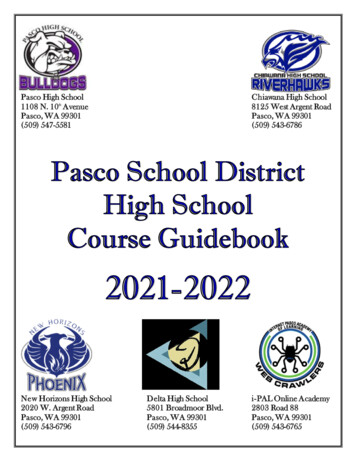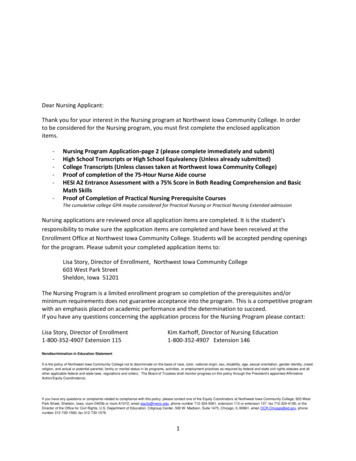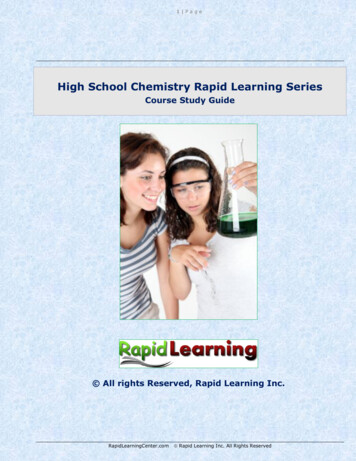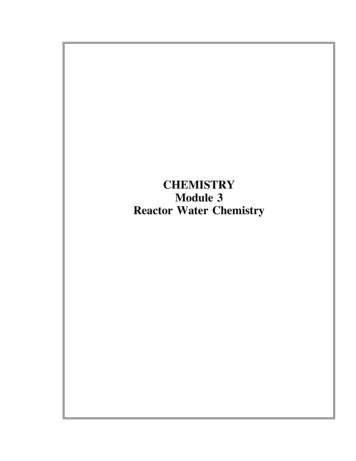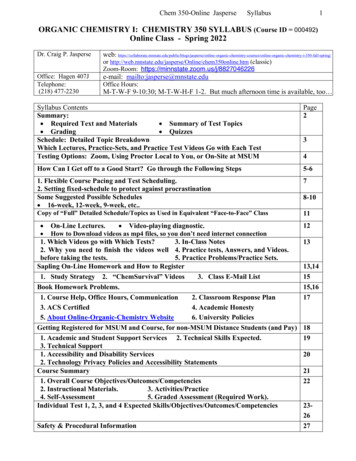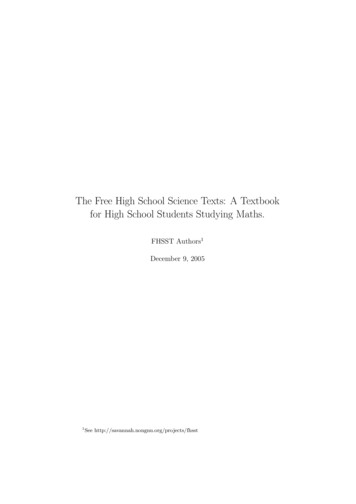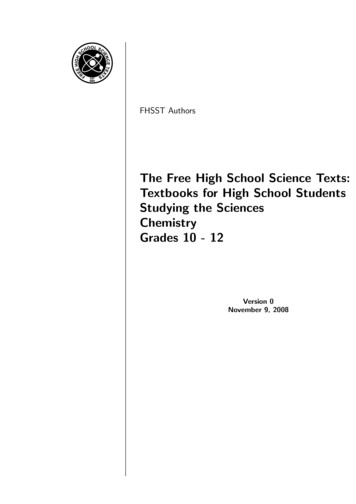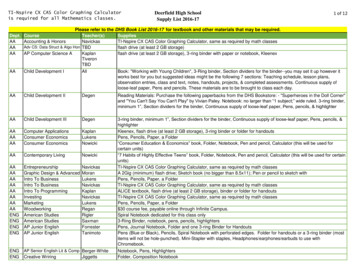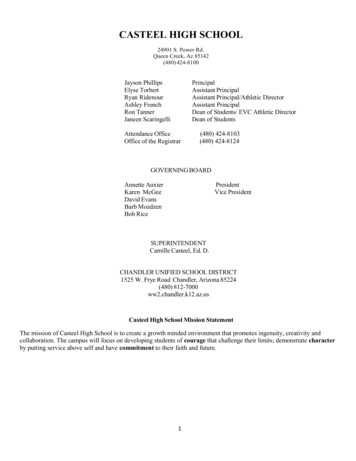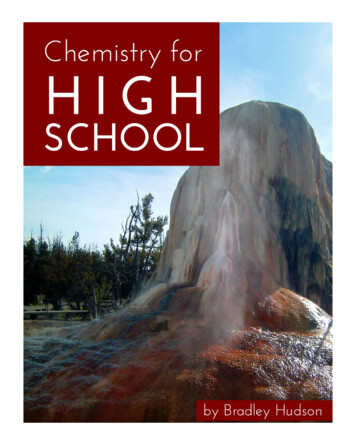
Transcription
Chemistry forHigh School1
2Chemistry for High SchoolFirst Edition, 2019Copyright @ Elemental Science, Inc.Email: support@elementalscience.comDigital EditionPrinted in the USA for worldwide distributionFor more copies write to:Elemental SciencePO Box 79Niceville, FL 32588support@elementalscience.comCopyright PolicyAll contents copyright 2019 by Elemental Science. All rights reserved.No part of this document or the related files may be reproduced or transmitted in any form, by any means(electronic, photocopying, recording, or otherwise) without the prior written permission of the author. The authordoes give permission to the original purchaser to photocopy the quizzes and appendix materials for use within theirimmediate family only.Limit of Liability and Disclaimer of Warranty: The publisher has used its best efforts in preparing this book, andthe information provided herein is provided “as is.” Elemental Science makes no representation or warranties withrespect to the accuracy or completeness of the contents of this book and specifically disclaims any implied warrantiesof merchantability or fitness for any particular purpose and shall in no event be liable for any loss of profit or anyother commercial damage, including but not limited to special, incidental, consequential, or other damages.Trademarks: This book identifies product names and services known to be trademarks, registered trademarks, orservice marks of their respective holders. They are used throughout this book in an editorial fashion only. In addition,terms suspected of being trademarks, registered trademarks, or service marks have been appropriately capitalized,although Elemental Science cannot attest to the accuracy of this information. Use of a term in this book should notbe regarded as affecting the validity of any trademark, registered trademark, or service mark. Elemental Science isnot associated with any product or vendor mentioned in this book.
Chemistry for High School Table of ContentsIntroductionIntroduction to this GuideAn Explanation of the SectionsWhat a full Lab Report should includeMore Information on Lab ReportsAdding Current Events into your Science StudiesThe Scientist Biography ReportThe In-depth ProjectThe Research Report77101213141617Unit 1: Introduction to ChemistryWeek 1 Notes - Introduction to ChemistryWeek 1 Supply ListWeek 1 Course Schedules202223Week 2 Notes - Matter and ChangeWeek 2 Supply ListWeek 2 Course Schedules262829Week 3 Notes - MeasurementsWeek 3 Supply ListWeek 3 Course Schedules323435Week 4 Notes - Atomic Structure, part 1Week 4 Supply ListWeek 4 Course Schedules384041Week 5 Notes - Atomic Structure, part 2Week 5 Supply ListWeek 5 Course Schedules444647Week 6 Notes - Electrons, part 1Week 6 Supply ListWeek 6 Course Schedules505253Week 7 Notes - Electrons, part 2Week 7 Supply ListWeek 7 Course Schedules565859Chemistry for High School - Table of Contents3
4Week 8 Notes - The Periodic TableWeek 8 Supply ListWeek 8 Course Schedules626465Week 9 Notes - NomenclatureWeek 9 Supply ListWeek 9 Course Schedules687071Unit 2: Bonding and ReactionsWeek 1 Notes - Ionic and Metallic BondingWeek 1 Supply ListWeek 1 Course Schedules767879Week 2 Notes - Covalent BondingWeek 2 Supply ListWeek 2 Course Schedules828485Week 3 Notes - The MoleWeek 3 Supply ListWeek 3 Course Schedules889091Week 4 Notes - Chemical ReactionsWeek 4 Supply ListWeek 4 Course Schedules949697Week 5 Notes - StoichiometryWeek 5 Supply ListWeek 5 Course Schedules100102103Week 6 Notes - States of Matter, Part 1Week 6 Supply ListWeek 6 Course Schedules106108109Week 7 Notes - States of Matter, part 2Week 7 Supply ListWeek 7 Course Schedules112114115Week 8 Notes - Behavior of Gases, part 1Week 8 Supply ListWeek 8 Course Schedules118120121Week 9 Notes - Behavior of Gases, part 2Week 9 Supply ListWeek 9 Course Schedules124126127Chemistry for High School - Table of Contents
5Unit 3: Water and EquilibriumWeek 1 Notes - WaterWeek 1 Supply ListWeek 1 Course Schedules132134135Week 2 Notes - Solutions, part 1Week 2 Supply ListWeek 2 Course Schedules138140141Week 3 Notes - Solutions, part 2Week 3 Supply ListWeek 3 Course Schedules144146147Week 4 Notes - Thermochemistry, part 1Week 4 Supply ListWeek 4 Course Schedules150152153Week 5 Notes - Thermochemistry, part 2Week 5 Supply ListWeek 5 Course Schedules156158159Week 6 Notes - KineticsWeek 6 Supply ListWeek 6 Course Schedules162164165Week 7 Notes - EquilibriumWeek 7 Supply ListWeek 7 Course Schedules168170171Week 8 Notes - Entropy and Free EnergyWeek 8 Supply ListWeek 8 Course Schedules174176177Unit 4: Organic Chemistry and MoreWeek 1 Notes - Acids and Bases, Part 1Week 1 Supply ListWeek 1 Course Schedules182184185Week 2 Notes - Acids and Bases, Part 2Week 2 Supply ListWeek 2 Course Schedules188190191Chemistry for High School - Table of Contents
6Week 3 Notes - Oxidation-Reduction ReactionsWeek 3 Supply ListWeek 3 Course Schedules194196197Week 4 Notes - ElectrochemistryWeek 4 Supply ListWeek 4 Course Schedules200202203Week 5 Notes - Nuclear ChemistryWeek 5 Supply ListWeek 5 Course Schedules206208209Week 6 Notes - Organic Chemistry, part 1Week 6 Supply ListWeek 6 Course Schedules212214215Week 7 Notes - Organic Chemistry, part 2Week 7 Supply ListWeek 7 Course Schedules218220221Week 8 Notes - Biochemistry, part 1Week 8 Supply ListWeek 8 Course Schedules224226227Week 9 Notes - Biochemistry, part 2Week 9 Supply ListWeek 9 Course Schedules230232233AppendixAdditional Supplies from Home Master Supply ListHands-on Activities Master Supply ListScientist Biography Report Grading RubricScience in the NewsChemistry for High School - Table of Contents239241243245
7Introduction to this GuideWelcome to Chemistry! This year, you will learn about matter, atomic structure, reactions,and much more. In this guide, you will find three types of schedules, as well as notes with theassignments for each week. To get links to the textbook, teacher guide, experiment, and quicklinks for the activities in this guide, please /chsThree Courses in OneThis guide contains the plans for three courses in one book. These are:)) Honors - The plans in this option are for a lab science, 1-credit Honors Chemistry course.There are textbook assignments, experiments, events in science, optional hands-onactivities, and written work with these plans. Expect to take about 5 to 6 hours a week tocomplete these plans. We recommend this option for students who plan on going intothe sciences. The honors course will also fulfill a lab science credit for graduation.)) Standard - The plans in this option are for a standard lab science, 1-credit High SchoolChemistry course. There are textbook assignments, experiments or online labs, and writtenwork with these plans. Expect to take about 4 to 5 hours a week to complete theseplans. We recommend this option for students who are not and for students who areplanning on going into the sciences. The standard course will fulfill a lab science credit forgraduation.)) Survey - The plans in this option are for an information-only, 1-credit Survey ofChemistry course. There are textbook assignments, written work, and events in sciencewith these plans. There are no experiments or hands-on activities scheduled with theseplans. Expect to take about 4 to 5 hours a week to complete these plans. We recommendthis option for students who are not planning on going into the sciences and do not needa lab science credit for graduation.Each of the scheduling pages will note at the top which course the plans are for. Theseschedules for these courses are suggestions; please check wil your local oversight contact to makesure that you are meeting your state’s graduation requirements. Please feel free to tailor thisprogram to the needs of your students.An Explanation of the SectionsAfter the scheduling pages, you will find the notes sheets. These sheets are divided into foursections - textbook, experiments, events in science, and hands-on activities. Here is an explanationof each of these sections.TextbookFor this study, we have chosen to use the standard text book, CK-12 Chemistry Intermediate.Chemistry for High School - Introduction
8You can download this text as a pdf from the resource page above. You will complete the readingassignment and then answer several of the questions from the text. These answers should be addedto the reading section of the science notebooks. You will also define several of the key terms fromthe chapter. The definitions should be added to the glossary section of the science notebook.ExperimentAll the experiments come from the Standard Home School Chemistry Laboratory Kit InstructionManual, along with the corresponding experiment kit. You can download the guide for free andpurchase the kit (CK01B Standard Home School Chemistry Laboratory Kit) from hpWith each of these experiments, you will find a purpose, required pre-reading, procedure, labnotebook assignments, and lab questions. For each week, we have included a supply list for yourconvenience. If you would like to see a full list of the household supplies you will need in additionto the experiment kit, please see pg. 239 in the Appendix.We have also incorporated an optional online lab into the standard course. These online labsare available through Beyond Labz. You can visit the resource page for this program for directionson how to sign up and use these labs or visit their website directly at:https://www.beyondlabz.com/As part of unit 1, the standard- and honors-course students will complete a full lab report forone of the experiments. We have included an explanation of what a full lab report includes afterthis introduction.Events in ScienceThis section gives two options for the Events in Science section. One will familiarize you withcurrent events in science, as you research on the internet for the various topics. The other willfamiliarize you with the key historical figures in chemistry through the scientist biography report.We have included two articles to explain these options in more depth following this introduction.Hands-on ActivitiesWe have also included optional hands-on experiments for each week. You can see a list of thesupplies you will need for these in the Appendix on pg. 241.The Science NotebookThis year, you will each create a science notebook. Each notebook should contain thefollowing sections:Chemistry for High School - Introduction
9Reading (All Students) - This section of the notebook will contain any notes you havetaken, along with the answers to the questions that were assigned each week.Lab (Standard- and Honors-Course Students Only) - This section of the notebook willhouse the notes from the experiments you have done, along with any other materialsrelating to the labs.Events (Survey- and Honors-Course Students Only) - This section of the notebook willinclude either the current events article summaries or the historical reports you have done.Glossary (All Students) - This section of the notebook will have the definitions for theassigned vocabulary words.This notebook can be a composition book, divided into the required sections, or a three-ringbinder with dividers for each section.Grading and CreditsThe three options in this guide meet the requirements for a full credit of high schoolchemistry, as explained above. Each week, the student will answer lab and textbook questions, doevents in science written work, and define vocabulary that can count toward a classwork grade forthe course. The textbook for this course has chapter tests available for free in the quizzes and testspacket. We suggest that you use these for the exam grade for the course. We suggest you use thefollowing percentages to come up with a final grade for the course:)) Class work: 70%)) Exam: 30%Note - A grading rubric for the Scientist Biography Reports can be found on pg. 243 in theAppendix.Students Going Into The SciencesIf your students plan to go on to major in the sciences, we suggest that you also add an indepth project and a research report at some point during the year to this program. An explanationof the in-depth project and of the research report can be found on the following pages.Final ThoughtsAs the authors and publishers of this curriculum, we encourage you to contact us with anyquestions or problems that you might have concerning Chemistry for High School at support@elementalscience.com. We will be more than happy to answer you as soon as we are able. Wetrust that you and your students will enjoy Chemistry for High School!Chemistry for High School - Introduction
19Chemistry forHigh SchoolUnit 1 - Introduction toChemistryChemistry for High School Unit 1
20Week 1 Notes - Introduction to ChemistryTextbook AssignmentsReadingCK-12 Chemistry Sections 1.1, 1.2WrittenAfter you finish reading, answer questions #1-4 in section 1.1 and #1-6 in section1.2 and file your work in the reading section of your science notebook. Then, define thefollowing terms in the glossary section of your science notebook: Analytical Chemistry Control Group Biochemistry Dependent Variable Macroscopic Independent Variable Pure Chemistry HypothesisExperiment - Setup A Lab NotebookPurposeThe purpose of this lab is to familiarize you with how to setup a lab notebook andprepare your lab notebook for use in the course.Pre-Reading Read the background and procedure sections for the “Setup A Lab Notebook” on pg. 12in The Home Scientist Chemistry Laboratory Manual.Procedure99 Do the lab entitled “Setup A Lab Notebook” on pg. 12 in The Home Scientist ChemistryLaboratory Manual.Lab Notebook)) Write down on a sheet of paper or type out your notes as you do the experiment. Afteryou are done, print out your lab notes and add them to the lab section of your sciencenotebook.Lab QuestionsÍÍThere are no lab questions for this week.Online Lab)) There is no online lab scheduled for this week.Events in ScienceCurrent Events Find a current events article relating to the field of chemistry and complete the articlesummary sheet found on pg. 245 of the Appendix. Once you are done, add the sheet tothe events section of your science notebook.Chemistry for High School Unit 1 - Week 1
21Historical Figures Begin to research the life and work of Dimitri Mendeleev, who orignally laid out the firstversion of the periodic table. You will have five weeks to complete your research. Afterthat, you will have three weeks to prepare a two to three page paper on this scientist andhis contributions to the field of chemsitry.Hands-on ActivityOptional Hands-on Use a bit of chemistry to mix up a batch of homemade ice cream! You will need ½ cupof heavy cream, ½ cup of milk, 1 tablespoon of sugar, ½ teaspoon of vanilla, 1 quart sizeziploc plastic bag, 2 cups of crushed ice, 1 gallon size ziploc plastic bag, and ½ cup of rocksalt. Add the cream, milk, sugar, and vanilla to the quart size baggie. Close the baggieand shake it vigorously to mix well. Next, add the ice and rock salt to the gallon sizebaggie, mix well, and then nestle the quart size bag into the ice mixture. Seal the largebaggie up tightly and begin massaging and shaking the baggies! (Note—It will take about10 to 15 minutes for ice cream to form. You can use a towel or oven mitt to hold the large baggieas you shake it, if it gets too cold to handle.)Chemistry for High School Unit 1 - Week 1
22Week 1 Supply ListWeekly ExperimentSupplies from CK01BChemistry Kit NoneAdditional SuppliesFrom Home NoneHands-on ActivitySupplies Needed Heavy cream, Milk, Sugar, Vanilla, 1 Quart size ziploc plastic bag,Crushed ice, 1 Gallon size ziploc plastic bag, Rock saltChemistry for High School Unit 1 - Week 1
23Week 1Unit 1 (Honors Course)5-DayWeekly TopicÎÎ This week will look at the principles of chemistry.Day 1Day 2Day 3 Read thebackgroundTextbook Read CK-12 Read CK-12andChemistryChemistryprocedureandSection 1.1.Section 1.2.sections forExperimentthe week’slab.WritingEvents inScience Add the Answer thevocabularyassignedto thequestions inglossarythe readingsection ofsection ofyour scienceyour sciencenotebook.notebook.Day 4Day 5 Do the“Setup A Lab Do theNotebook”optionallab on pg. 12Hands-onin The HomeAssignmentScientist- HomemadeChemistryIce Cream.LaboratoryManual. Record whatyou havedone in thelab section ofyour sciencenotebook. Complete thelab reviewquestions forthe week. Choose one of the Events in Science assignments to do and add your work to the eventssection of your science notebook.Other NotesChemistry for High School Unit 1 - Week 1
24Week 1Unit 1 (Standard Course)4-DayWeekly TopicÎÎ This week will look at the principles of chemistry.Day 1Day 2TextbookandExperiment Read CK-12ChemistrySection 1.1. Read CK-12ChemistrySection 1.2.Writing Add thevocabulary tothe glossarysection ofyour sciencenotebook. Answer theassignedquestions inthe readingsection ofyour sciencenotebook.Day 3Day 4 Read thebackground andprocedure sectionsfor the week’s lab. Do the “Setup ALab Notebook”lab on pg. 12in The HomeScientist ChemistryLaboratory Manual.Other NotesChemistry for High School Unit 1 - Week 1 Record what youhave done in thelab section of yourscience notebook.
25Week 1Unit 1 (Survey Course)2-DayWeekly TopicÎÎ This week will look at the principles of chemistry.Day 1Day 2Textbook Read CK-12 Chemistry Section 1.1. Read CK-12 Chemistry Section 1.2.Writing Add the vocabulary to the glossarysection of your science notebook. Answer the assigned questions in thereading section of your science notebook.Events inScience Choose one of the Events in Science assignments to do and add your work to the eventssection of your science notebook.Other NotesChemistry for High School Unit 1 - Week 1
26Week 2 Notes - Matter and ChangeTextbook AssignmentsReadingCK-12 Chemistry Sections 2.1, 2.2, 2.3WrittenAfter you finish reading, answer questions #1,3,5 in section 2.1, questions #1-4 in section2.2, and questions #4-7 in section 2.3. File your work in the reading section of your sciencenotebook. Then, define the following terms in the glossary section of your science notebook: Intensive Property Homogeneous Mixture Extensive Property Precipitate Volume Product Distillation Reactant Heterogeneous Mixture PhaseExperiment - Solubility As A Function of TemperaturePurposeThe purpose of this lab is to examine the solubility as a function of temperaturePre-Reading Read the background and procedure sections for the “Solubility as a Function ofTemperature” lab on pg. 35 in The Home Scientist Chemistry Laboratory Manual.Procedure99 Do the lab entitled “Solubility as a Function of Temperature” on pg. 35 in The HomeScientist Chemistry Laboratory Manual.Lab Notebook)) Write down on a sheet of paper or type out your notes as you do the experiment. Afteryou are done, print out your lab notes and add them to the lab section of your sciencenotebook.Lab QuestionsÍÍComplete the review questions of the “Solubility as a Function of Temperature” lab onpg. 41 in The Home Scientist Chemistry Laboratory Manual. Record the answers in the labsection of your science notebook.Online Lab - Lab 3: Counting by Measuring MassPurposeThe purpose of this online lab is to determine the mass of several samples of chemicalelements and compounds and to use the data to count atoms.Pre-Reading Print and read the section of the workbook for the “Counting by Measuring Mass” onlinelab.Chemistry for High School Unit 1 - Week 2
27Procedure99 Do the lab entitled “Counting by Measuring Mass” and answer the questions as you workthrough the online lab.Lab Notebook)) Add the completed workbook pages that were printed to the lab notebook.Events in ScienceCurrent Events Find a current events article relating to the field of chemistry and complete the articlesummary sheet found on pg. 245 of the Appendix. Once you are done, add the sheet tothe events section of your science notebook.Historical Figures Continue to research the life and work of Dmitri Mendeleev.Hands-on ActivityOptional Hands-on Watch water change from a solid to a liquid to a gas. You will need a cup, ice cubes, apot, and a thermometer. Fill a small pot halfway with ice cubes. Place the pot on a burnerand turn the burner on medium heat. Observe the thermometer as the ice begins to meltand record the temperature once all the ice melts. Continue to heat the water, observingthe temperature on the thermometer as it heats up. Once you begin to see the waterboiling and observe the presence of steam, record your last temperature measurement.Turn the burner off and remove the pot from the burner.Chemistry for High School Unit 1 - Week 2
28Week 2 Supply ListWeekly ExperimentSupplies from CK01BChemistry Kit Goggles, Beaker-250 mL, ThermometerAdditional SuppliesFrom Home Gloves, Balance (optional), Microwave oven, Oven - baking dish,Refrigerator/freezer, Measuring spoons (optional), Soda bottle- pint/500mL (empty and clean), Storage container (wide mouth, with lid),Sodium bicarbonate (baking soda), Distilled waterHands-on ActivitySupplies Needed Cup, Ice cubes, Pot, ThermometerChemistry for High School Unit 1 - Week 2
29Week 2Unit 1 (Honors Course)5-DayWeekly TopicÎÎ This week will look at matter and changes to matter.Day 1Day 2Day 3Day 4 Do the“Solubility asa Function of Read the Read CK-12Temperature”Textbook Read CK-12backgroundChemistrylab on pg. 35Chemistryand procedureandSections 2.1in The HomeSection 2.3.sections forExperimentand 2.2.Scientistthe week’s lab.ChemistryLaboratoryManual.WritingEvents inScience Add the Answer thevocabularyassignedto thequestions inglossarythe readingsection ofsection ofyour scienceyour sciencenotebook.notebook. Take theChapter 1Test fromCK-12Chemistry. Record whatyou havedone in thelab section ofyour sciencenotebook.Day 5 Do theoptionalHands-onAssignment- Changes inState. Completethe labreviewquestions forthe week. Choose one of the Events in Science assignments to do and add your work to the eventssection of your science notebook.Other NotesChemistry for High School Unit 1 - Week 2
30Week 2Unit 1 (Standard Course)4-DayWeekly TopicÎÎ This week will look at matter and changes to matter.Day 1TextbookandExperimentDay 2 Read CK-12ChemistrySections 2.1and 2.2. Read CK-12ChemistrySection 2.3.Day 3Day 4 Do the “Solubilityas a Function ofTemperature”lab on pg. 35 Read thein The Homebackground andScientist Chemistryprocedure sectionsLaboratory Manual.for the week’s lab.OR Do the onlinelab “Counting byMeasuring Mass.”Writing Add thevocabulary tothe glossarysection ofyour sciencenotebook. Answer theassignedquestions inthe readingsection ofyour sciencenotebook. Take the Chapter1 Test from CK12 Chemistry.Other NotesChemistry for High School Unit 1 - Week 2 Record what youhave done in thelab section of yourscience notebook.
31Week 2Unit 1 (Survey Course)2-DayWeekly TopicÎÎ This week will look at matter and changes to matter.Day 1TextbookWritingEvents inScience Read CK-12 Chemistry Sections 2.1 and2.2. Add the vocabulary to the glossarysection of your science notebook. Take the Chapter 1 Test from CK-12Chemistry.Day 2 Read CK-12 Chemistry Section 2.3. Answer the assigned questions in thereading section of your science notebook. Choose one of the Events in Science assignments to do and add your work to the eventssection of your science notebook.Other NotesChemistry for High School Unit 1 - Week 2
32Week 3 Notes - MeasurementsTextbook AssignmentsReadingCK-12 Chemistry Section 3.1, 3.2, 3.3WrittenAfter you finish reading, answer questions #1-4 in section 3.1, #1-6 in section 3.2, and#1-5 in section 3.3. File your work in the reading section of your science notebook. Then,define the following terms in the glossary section of your science notebook: International System of Units (SI) Accepted Value Joule Derived Unit Kinetic Energy pH Scientific Notation Polarity Conversion Factor Accuracy Dimensional Analysis PrecisionExperiment - Conductance of Ionic and Molecular SolutesPurposeThe purpose of this lab is to examine the conductance of ionic and molecular solutes.Pre-Reading Read the background and procedure sections for the “Conductance of Ionic andMolecular Solutes” lab on pg. 42 in The Home Scientist Chemistry Laboratory Manual.Procedure99 Do the lab entitled “Conductance of Ionic and Molecular Solutes” on pg. 42 in The HomeScientist Chemistry Laboratory Manual.Lab Notebook)) Write down on a sheet of paper or type out your notes as you do the experiment. Afteryou are done, print out your lab notes and add them to the lab section of your sciencenotebook.Lab QuestionsÍÍComplete the review questions of the “Conductance of Ionic and Molecular Solutes” labon pg. 48 in The Home Scientist Chemistry Laboratory Manual. Record the answers in thelab section of your science notebook.Online Lab - Lab 2: Names and Formulas of Ionic CompoundsPurposeThe purpose of this online lab is to observe the formation of compounds and write theirnames and formulas.Chemistry for High School Unit 1 - Week 3
33Pre-Reading Print and read the section of the workbook for the “Names and Formulas of IonicCompounds” online lab.Procedure99 Do the lab entitled “Names and Formulas of Ionic Compounds” and answer thequestions as you work through the online lab.Lab Notebook)) Add the completed workbook pages that were printed to the lab notebook.Events in ScienceCurrent Events Find a current events article relating to the field of chemistry and complete the articlesummary sheet found on pg. 245 of the Appendix. Once you are done, add the sheet tothe events section of your science notebook.Historical Figures Continue to research the life and work of Dmitri Mendeleev.Hands-on ActivityOptional Hands-on Practice units of measurements using the information in the following post: ies/units-of-measurement.Chemistry for High School Unit 1 - Week 3
34Week 3 Supply ListWeekly ExperimentSupplies from CK01BChemistry Kit Goggles, Beaker-250 mL, Beaker-100 mL, Centrifuge tube-50 mL,Pipettes, Reaction plate 24-well, Spatula, Acetic acid 6M, Ammonia6M, Hydrochloric acid 6M, Magnesium sulfate, Sodium hydroxide 6MAdditional SuppliesFrom Home Gloves, Digital multimeter (DMM) with probes, Microwave oven,Paper towels, Soda bottle (clean and dry), Sucrose (table sugar), DistilledwaterHands-on ActivitySupplies Needed NoneChemistry for High School Unit 1 - Week 3
35Week 3Unit 1 (Honors Course)5-DayWeekly TopicÎÎ This week will look at units of measurement.Day 1Day 2Day 3Day 4Day 5 Do the“Conductanceof Ionic and Do the Read theMolecular Read CK-12optionalTextbook Read CK-12backgroundSolutes” labChemistryHands-onChemistryand procedureon pg. 42 inandSections 3.1AssignmentSection 3.3.sections forThe HomeExperimentand 3.2.- Units ofthe week’s .WritingEvents inScience Add the Answer thevocabularyassignedto thequestions inglossarythe readingsection ofsection ofyour scienceyour sciencenotebook.notebook. Take theChapter 2Test fromCK-12Chemistry. Record whatyou havedone in thelab section ofyour sciencenotebook. Complete thelab reviewquestions forthe week. Choose one of the Events in Science assignments to do and add your work to the eventssection of your science notebook.Other NotesChemistry for High School Unit 1 - Week 3
36Week 3Unit 1 (Standard Course)4-DayWeekly TopicÎÎ This week will look at units of measurement.Day 1TextbookandExperimentDay 2 Read CK-12ChemistrySections 3.1and 3.2. Read CK-12ChemistrySection 3.3.Day 3Day 4 Do the“Conductance ofIonic and MolecularSolutes” lab on Read thepg. 42 in The HomebackgroundScientist Chemistryand procedureLaboratory Manual.sections for theweek’s lab.OR Do the online lab“Names and Formulasof Ionic Compounds.”Writing Add thevocabulary tothe glossarysection ofyour sciencenotebook. Answer theassignedquestions inthe readingsection ofyour sciencenotebook. Take the Record what youChapter 2 Testhave done in thefrom CK-12lab section of yourChemistry.science notebook.Other NotesChemistry for High School Unit 1 - Week 3
37Week 3Unit 1 (Survey Course)2-DayWeekly TopicÎÎ This week will look at units of measurement.Day 1TextbookWritingEvents inScience Read CK-12 Chemistry Sections 3.1 and3.2. Add the vocabulary to the glossarysection of your science notebook. Take the Chapter 2 Test from CK-12Chemistry.Day 2 Read CK-12 Chemistry Section 3.3. Answer the assigned questions in thereading section of your science notebook. Choose one of the Events in Science assignments to do and add your work to the eventssection of your science notebook.Other NotesChemistry for High School Unit 1 - Week 3
237Chemistry forHigh SchoolAppendix
239Additional Supplies from Home Master Supply ListUnit 1: Introduction to ChemistryWeek123456789No additional supplies neededGloves, Balance (optional), Microwave oven, Oven - baking dish, Refrigerator/freezer, Measuring spoons (optional), Soda bottle- pint/500 mL (empty andclean), Storage container (wide mouth, with lid), Sodium bicarbonate (bakingsoda), Distilled waterGloves, Digital multimeter (DMM) with probes, Microwave oven, Paper towels,Soda bottle (clean and dry), Sucrose (table sugar), Distilled waterGloves, Balance (optional), Foam cups (or similar containers), Freezer, Measuringspoons (if no balance), Sodium chloride (table salt), Sucrose (table sugar),Distilled water, Ice (crushed or chipped)Gloves, Microwave oven, Refrigerator, Soda bottles (empty), Watch or clock withsecond hand, Distilled white vinegar (supermarket), Graphing paper/calculator/softwareGloves, Microwave oven, Oven mitts or tongs, Paper (sheet of copy paper orsimilar), Paper towels, Refrigerator/freezer, Tablespoon (measuring
Chemistry or igh chool - Introduction Introduction to this Guide Welcome to Chemistry! This year, you will learn about matter, atomic structure, reactions, and much more. In this guide, you will find three types of schedules, as well as notes with the assignments for each week. To get links to the
